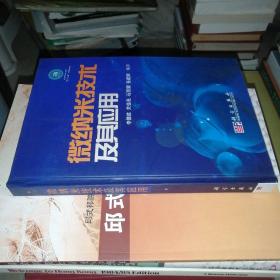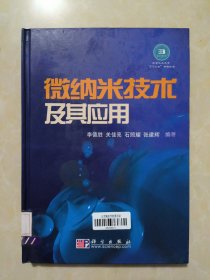
纳米技术原理——微系统中基于分子的凝聚态研究(英文影印版)
¥ 8 2.0折 ¥ 40 九品
仅1件
江苏淮安
认证卖家担保交易快速发货售后保障
作者[美]曼索里 著
出版社复旦大学出版社
出版时间2006-11
版次1
装帧平装
货号沪260
上书时间2024-07-21
- 在售商品 暂无
- 平均发货时间 10小时
- 好评率 暂无
- 最新上架
商品详情
- 品相描述:九品
- 内有少量划痕
图书标准信息
- 作者 [美]曼索里 著
- 出版社 复旦大学出版社
- 出版时间 2006-11
- 版次 1
- ISBN 9787309052060
- 定价 40.00元
- 装帧 平装
- 开本 其他
- 纸张 胶版纸
- 【内容简介】
-
纳米技术最先由诺贝尔物理学奖获得者、著名的物理学家理查德·费曼在1959年12月29日的一次报告中提出来的。20世纪80年代,扫描探针显微镜发明之后,纳米技术开始快速发展,现在它已成为物品设计和制作中最活跃的前沿应用领域。本书就是作者根据自己37年的研究工作,在给伊利诺依(Illinois)大学的工程、生物和物理类研究生和读过量子力学、统计力学的高年级大学生讲课的讲稿基础上撰写而成的。全书强调在凝聚态物质的分子研究基础上,重点介绍微系统的有趣课题。全书共分11章,分别讲述原子、分子纳米技术的进展;纳米系统中分子间的作用力和势函数;纳米系统的热力学和统计力学;纳米系统的Monto Carlo模拟法;纳米系统的动力学模拟法;纳米系统的计算机模拟和最优化;纳米系统的相变;原子分子的定位安装;分子自组装;动力学组合化学;分子组装的鸟笼结构等。全书提供了丰富的进一步研究的参考文献。
本书除了可用作相关专业的研究生教材和本科生选修课教材之外,还可作为有关专家了解纳米系统学科概貌的参考读物。本书的细致解释,一定会引起读者的广泛关注。考虑到纳米技术是一门跨学科的交叉学科,本书还附上术语解释,包括了缩略语、化学方程式、概念定义、方程和理论等方面,这将为不同学科的读者提供阅读的方便。 - 【作者简介】
- 曼索里,G.Ali Mansoori,美国Illinois大学生物工程和化学工程系教授、博士。 作者致力于将统计力学和热力学应用于化学工程和生物工程之中,研究范围涉及重油利用、沥青质特征、天然气净化、超临界流体的提取、生物技术和环境污染等。作者已经取得了以下成果:确立了可用
- 【目录】
-
Preface
Chapter 1 — Advances in Atomic and Molecular Nanotechnology
Introduction
The Importance of Nanoscale
Atomic and Molecular Basis of Nanotechnology
Some Recent Key Inventions and Discoveries
Scanning Tunneling Microscope
Atomic Force Microscope
Diamondoids
Buckyballs
Carbon Nanotubes
Cyclodextrins, Liposome and Monoclonal Antibody
Ongoing Research and Development Activities
Future Prospects in Nanoscience and Nanotechnology
Conclusions and Discussion
Some Important Related INTERNET Sites
Bibliography
Chapter 2 — Nanosystems Intermolecular Forces and Potentials
Introduction
Covalent and Noncovalent Interactions
Interatomic and Intermolecular Potential Energies and Forces
Experimental and Theoretical Development of Interparticle Potentials
Step (1): AFM Measurement and Empirical Modeling
Step (2): Theoretical Modeling
Linearized Augmented Plane Wave (LAPW)
Full-Potential Linearized Augmented Plane Wave (FLAPW)
Step (3): Development of Nanoparticle Potentials
Phenomenological Interatomic and Intermolecular Potentials
1. Interatomic Potentials for Metallic Systems
1.1. The Many-Body Embedded-Atom Model (EAM) Potentials
1.2. The Many-Body Finnis and Sinclair (FS) Potentials
1.3. The Many-Body Sutton and Chen (SC) Long-Range Potentials
1.4. The Many-Body Murrell-Mottram (MM) Potential
1.5. The Many-Body Rafii-Tabar and Sutton (RTS) Long-Range Alloy Potentials
1.6. Angular-Dependent Potentials
2. Interatomic Potentials for Covalently-Bonding Systems
2.1. The Tersoff Many-Body C-C, S i-Si and C-Si Potentials
2.2. The Brenner-Tersoff-Type First Generation Hydrocarbon Potentials
2.3. The Brenner-Tersoff-Type Second Generation Hydrocarbon Potentials
3. Interatomic Potential for C-C Non-Covalent Systems
3.1. The Lennard-Jones and Kihara Potentials
3.2. The exp-6 Potential
3.3. The Ruoff-Hickman Potential
4. Interatomic Potential for Metal-Carbon System
5. Atomic-Site Stress Field
Conclusions and Discussion
Bibliography
Chapter 3 — Thermodynamics and Statistical Mechanics of Small Systems
Chapter 4 — Monte Carlo Simulation Methods for Nanosystems
Chapter 5 — Molecular Dynamics Simulation Methods for Nanosystems
Chapter 6 — Computer-Based Simulations and Optimizations for Nanosystems
Chapter 7 — Phase Transitions in Nanosystems
Chapter 8 — Positional Assembly of Atoms and Molecules
Chapter 9 — Molecular Self-Assembly
Chapter 10 — Dynamic Combinatorial Chemistry
Chapter 11 — Molecular Building Blocks — Diamondoids
Glossary
Index
点击展开
点击收起
相关推荐
— 没有更多了 —























以下为对购买帮助不大的评价